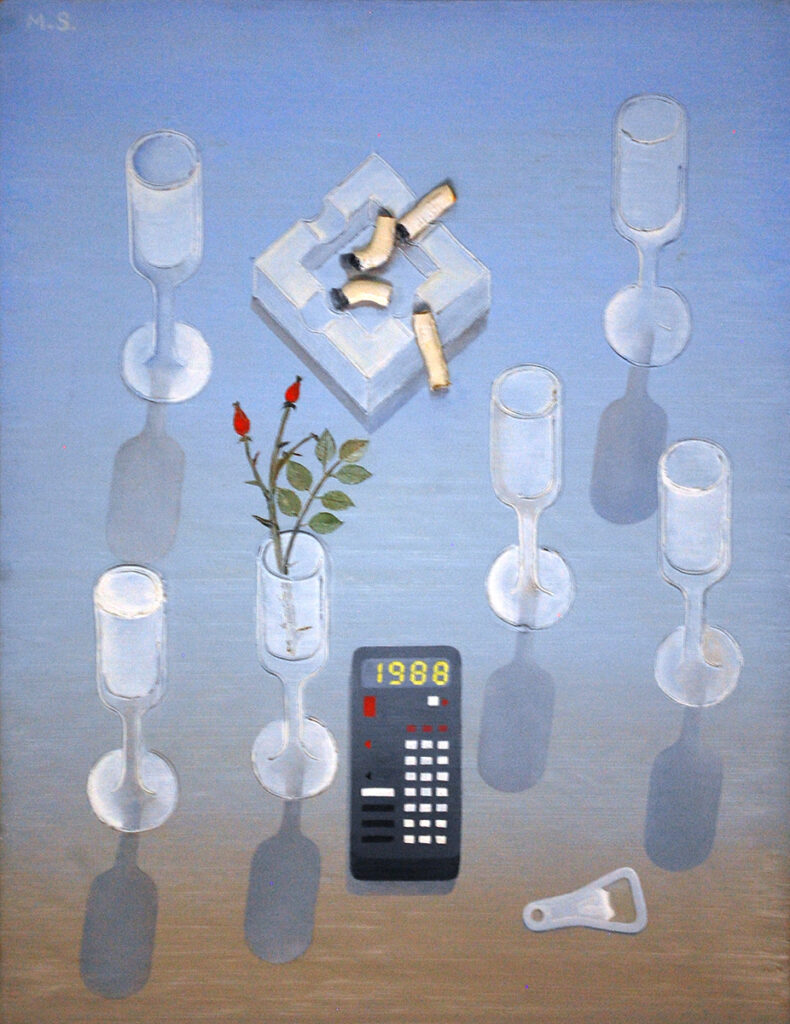Michal Studený entered the art scene in the 1960s and belongs to a generation of artists who have tried to redefine the purpose of the image, even though his works are not as radical as the works of Vladimír Popovič, Alex Mlynárčik and Stanislav Filko that he met at Peter Matejka’s Department of Monumental Painting at AFAD. Iva Mojžišová wrote about his early works in 1967: “He paints meticulous images of silent landscapes, things and people and enriches their visuals with the naive simplicity of his own feelings” (Slovník súčasného slovenského umenia. [Contemporary Slovak Art Dictionary.] Bratislava 1967). Later, he starts to add various trivial found objects to his images, like broken ceramic or mirror fragments, buttons, wires, but also natural materials like cloverleaves (Image, 1969), feathers (Tribute to Eliáš Havetta, 1968) which he often multiplies in the image. In one lineage of his work, he turns to the themes of the house and the church which he incorporates as archetypal symbols. Despite their main shapes being attenuated, they are based, as the artist himself admits[1], on real-life structures, mostly the Roman church in Kostoľany pod Tribečom.
The Contemporary Still Life image is from the 1980s when the artist had already been on the art scene for twenty years. What connects him to his early works from the 1960s is the depicted reality of ordinary life. The image captures trivial everyday objects such as wine glasses, an ashtray with cigarette butts, a bottle opener, flowers and a calculator displaying the number 1988 in reference to the year of creation. In this sense, it is a record of visual reality that reflects man’s material life of the late 1980s, but also a personal message by the artist in the form of a page pulled out of his diary. He had already worked on a similar theme in a drawing of his titled Early Spring – Image Sketch (1987, today, it is a part of the collection of the Art Gallery of Považie in Žilina) which also depicts an ashtray, a calculator, but the composition also includes other period objects – car keys, a pen, an envelope…
The Contemporary Still Life could be interpreted on two different levels when it comes to its genre. On one hand, as the title suggests, it is a still life. In comparison with historical still lifes like Memento Mori or Vanitas, that include objects symbolising ephemerality – a clock, skull, candle, fresh flowers, fruit (foreshadowing their decay) – Studený depicts various objects that are in use today which brings him closer to Tom Wesselmann’s Pop art still lifes from the 1960s. However, Studený also somewhat ironises his own way of life and refers to his indulgences, such as social smoking and drinking. Only the presence of a flower – rosehip in a vase – suggesting human mortality and ephemerality, could be considered a reference to the historical still life. On the other hand, we could read the image as a portrait, the genre, which is, along with the self-portrait, almost absent from the art world of the second half of the 20th century. And even when it is not, it suppresses its typical features, such as the face. An example could be the Tormented Self-Portrait (1987-1988) by Ashley Bickerton (1959) from the same period as Studený’s still life. The artist uses ironic hyperbole in a collage of name brands that are a part of his world to define himself and his lifestyle (Marlboro cigarettes, Citibank, Renault, Bayer Aspirin etc.). From this point of view, Studený’s image could be perceived as an atypical self-portrait contemplating the traditional notion of mimetic and psychological self-presentation. The same would be true if we considered Studený’s work a portrait that has more to say about the society and its attributes than specific individuals.
Barbora Geržová
November 2020
Michal Studený was born on January 12, 1939 in Prague where his father, an important Slovak painter František Studený (1911-1980), worked at the time. He grew up in Tisovec, his family moved to Bratislava in 1945. From 1953 to 1957, he studied printmaking at the Secondary School of Applied Arts in Bratislava and from 1957 to 1963, he attended the Department of Applied Printmaking at the Academy of Fine Arts and Design in Bratislava. In 1960, he switched to the Department of Monumental Painting (prof. Matejka). He is a painter, illustrator and printmaker. He has worked as the graphic designer of the legendary magazine Mladá tvorba [Young Creatives], illustrated books and magazines for children (Zornička, Ohník and Včielka ). He has worked with other artists like Peter Bartoš (they held their first exhibition at the C. Majerník Gallery in 1967), Vladimír Popovič and the director Elo Havetta (he dedicated him the Tribute to Eliáš Havetta, 1968) that he met during his secondary school studies.
Sources
[1] https://kultura.pravda.sk/galeria/clanok/473258-maliar-alchymista-dokaze-malovat-aj-padacikmi-pupav/
Bibliography
Michal Studený a kol.: Michal Studený – som dieťa šesťdesiatych rokov [Michal Studený and others: Michal Studený – I’m a Child of the 1960s]. Bratislava: Vydavateľstvo O.K.O. [O.K.O. Publishing], 2009.
Michal Studený: Som dieťa šesťdesiatych rokov [Michal Studený – I’m a Child of the 1960s]. Exhibition Catalogue. Text by I. Mojžišová. Bratislava 2005.
Michal Studený. Text by: Ľ. Hološka, V. Popovič. Bratislava: Agentúra O.K.O. [O.K.O. Agency], 1997.
Inventory No.: O-1875
Artist: Michal Studený
Title: Contemporary Still Life
Year of origin: 1988
Technique: mixed media
Material: cardboard
Dimensions: 65,5 × 50 cm
Signature: top left M. S.
